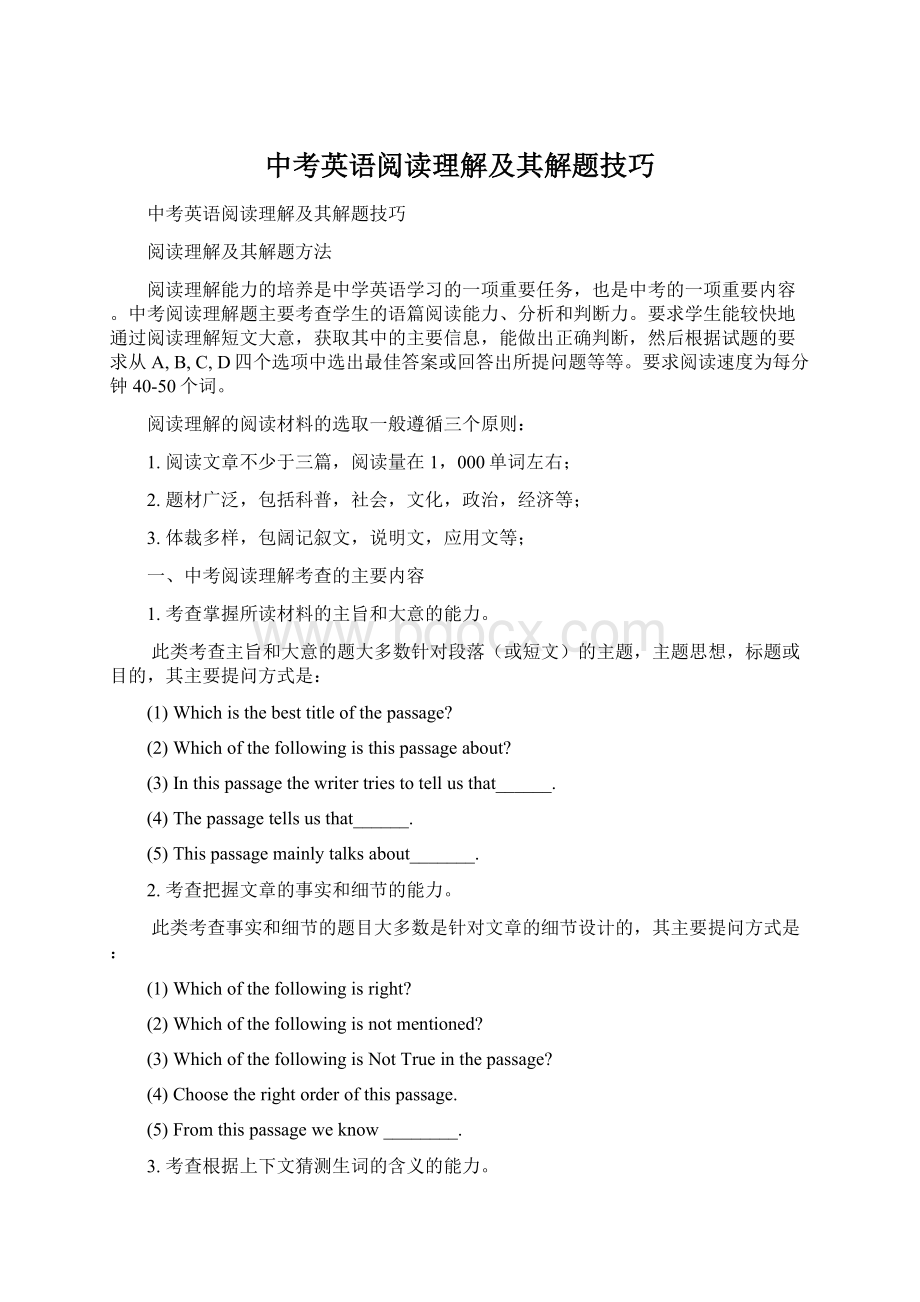中考英语阅读理解及其解题技巧.docx
《中考英语阅读理解及其解题技巧.docx》由会员分享,可在线阅读,更多相关《中考英语阅读理解及其解题技巧.docx(14页珍藏版)》请在冰豆网上搜索。

中考英语阅读理解及其解题技巧
中考英语阅读理解及其解题技巧
阅读理解及其解题方法
阅读理解能力的培养是中学英语学习的一项重要任务,也是中考的一项重要内容。
中考阅读理解题主要考查学生的语篇阅读能力、分析和判断力。
要求学生能较快地通过阅读理解短文大意,获取其中的主要信息,能做出正确判断,然后根据试题的要求从A,B,C,D四个选项中选出最佳答案或回答出所提问题等等。
要求阅读速度为每分钟40-50个词。
阅读理解的阅读材料的选取一般遵循三个原则:
1.阅读文章不少于三篇,阅读量在1,000单词左右;
2.题材广泛,包括科普,社会,文化,政治,经济等;
3.体裁多样,包阔记叙文,说明文,应用文等;
一、中考阅读理解考查的主要内容
1.考查掌握所读材料的主旨和大意的能力。
此类考查主旨和大意的题大多数针对段落(或短文)的主题,主题思想,标题或目的,其主要提问方式是:
(1)Whichisthebesttitleofthepassage?
(2)Whichofthefollowingisthispassageabout?
(3)Inthispassagethewritertriestotellusthat______.
(4)Thepassagetellsusthat______.
(5)Thispassagemainlytalksabout_______.
2.考查把握文章的事实和细节的能力。
此类考查事实和细节的题目大多数是针对文章的细节设计的,其主要提问方式是:
(1)Whichofthefollowingisright?
(2)Whichofthefollowingisnotmentioned?
(3)WhichofthefollowingisNotTrueinthepassage?
(4)Choosetherightorderofthispassage.
(5)Fromthispassageweknow________.
3.考查根据上下文猜测生词的含义的能力。
此类猜测词义的题目要求考生根据上下文确定某一特定的词或短语的准确含义。
其主要提问方式是:
(1)Theword“x”inthepassageprobablymeans________.
(2)Theunderlinedword“It”inthepassagerefersto_______.
(3)Inthisstorytheunderlinedword“x”means________.
(4)Here“it”means________.
4.考查对阅读材料全篇的逻辑关系的理解,对文章各段,各句之间的逻辑关系的理解能力。
此类题目主要考查的是句与句之间,短语短之间的逻辑关系,其主要提问方式是:
(1)Manyvisitorscometothewriter’scityto________.
(2)Airpollutionisthemostseriouskindofpollutionbecause_____.
(3)WhydidthewritergetoffthetraintwostopsbeforeViennastation?
5.考查依据短文内容和考生应有的常识进行推理和判断的能力。
此类题目文章中没有明确的答案,需要考生再理解全文的基础上进行推理和判断。
其主要提问方式是:
(1)Wecanguessthewriterofthelettermaybea______.
(2)Wecaninferfromthetextthat_______.
(3)Fromtheletterswe’velearnedthatit’svery_____toknowsomethingaboutAmericansocialcustoms.
(4)Fromthestorywecanguess______.
(5)Whatwouldbehappyif…?
6.考查推断作者意图和态度的能力。
其主要提问方式是:
(1)HowdidthewriterfeelatViennastation?
(2)Thewriterwritesthistextto______.
(3)Thewriterbelievesthat______.
(4)Thewritersuggeststhat______.
二、阅读理解题的方法和技巧
1.如何获取段落的主旨和大意?
最有效的办法是找出主题句。
一篇文章(或一段文章)通常都是围绕一个中心意思展开的。
而这个中心意思往往由一个句子来概括。
这个能概括文章或段落中心意思的句子叫做主题句。
因此,理解一个段落或一篇文章的中心意思首先要学会寻找主题句。
在一篇短文或一个段落中,大部分主题句的情况有三种:
(1)主题句在段首或篇首。
主题句在段首或篇首的情况相当普遍。
一般新闻报道、说明文,议论文大都采用先总述,后分述的叙事方法。
例如:
Alllivingthingsontheearthneedotherlivingthingstolive.Nothinglivesalone.Mostanimalsmustliveinagroup,andevenaplantgrowsclosetogetherwithothersofthesamekind.Sometimesonelivingthingkillsanother,oneeatsandtheotheriseaten.Eachkindoflifeeatsanotherkindoflifeinordertolive,andtogethertheyformafoodchain(食物链)。
Somefoodchainsbecomebrokenupifoneofthelinksdisappears
Whichofthefollowingdoyouthinkisthebesttitleforthispassage?
A.AnimalsB.PlantsC.FoodChainsD.LivingThings
(2)主题句在段末或篇末。
用归纳法写文章时,往往表述细节的句子在前,概述性的句子在后,并以此结尾。
这种位于段末或篇末的主题句往往是对前面细节的总结,归纳或结论。
例如:
Ifyoubuysomewell-madeclothes,youcansavemoneybecausetheycanlastlonger.
Theylookgoodevenaftertheyhavebeenwashedmanytimes.Sometimessomeclothescostmoremoney,butitdoesnotmeanthattheyarealwaysbettermade,ortheyalwaysfitbetter.Inotherwords,somelessexpensiveclotheslookandfitbetterthanmoreexpensiveclothes.
(3)无主题句
有时,一篇文章里并没有明显的主题句。
这时我们应该怎样来确定文章的主题或中心意思呢?
其实这也不难。
我们可以首先找出每一段的中心意思,各段的中心意思往往都是围绕一个中心来展开的,或者说是来说明一个问题的。
这个中心或这个问题就是这篇文章的主题或中心意思。
例如:
KillerbeesstartedinBrazil1957.AscientistinSaoPaulowantedbeestomakemorehoney(蜂蜜).Soheputforty-sixAfricanbeeswithsomeBrazilianbees.Thebeesbred(繁殖)andmadeanewkindofbees.Butthenewbeeswereamistake.Theydidn’twanttomakemorehoney.Theywantedtoattack.Then,byaccident,twenty-sixAfricanbeesescapedandbredwiththeBrazilianbeesoutside.
Scientistscouldnotcontrol(控制)theproblem.Thebeesincreasedfast.TheywentfromBraziltoVenezuela.ThentheywenttoCentralAmerica.NowtheyareinNorthAmerica.Theytravelabout390milesayear.Eachgroupofbeesgrowsfourtimesayear.Thismeansonemillionnewgroupseveryfiveyears.
Whyarepeopleafraidofkillerbees?
Peopleareafraidfortworeasons.First,thebeessting(叮)manymoretimesthanusualbees.Killerbeescanstingsixtytimesaminutenonstopfortwohours.Second,killerbeesattackingroups.Fourhundredbeestingscankillaperson.
Alreadyseveralhundredpeoplearedead.NowkillerbeesareinTexas.InafewyearstheywillreachallovertheUnitedStates.Peoplecandonothingbutwait.
Thebesttitleofthepassageis____________.
A.HowtomakemorehoneyB.Killerbees
C.AfoolishscientistD.Howtofeedkillerbees
2.如何根据上下文猜测词义?
猜测词义也是一种英语阅读能力。
英语阅读理解试题中有不少这样的题目。
任何一个实词,只有在一定的上下文中才能表示一个确定的词义。
所谓上下文(context),正如英语辞典所解释的,其作用就是帮助确定上下文中的词、短语或句子的意义。
据此,我们
可以尽可能地利用上下文来猜测词义,即从已知推求未知,也就是用我们所熟悉的词或短语来猜测我们不熟悉的词的词义。
猜测词义时,我们可以从三个方面来考虑:
1)根据上下文已知部分进行逻辑上的推理。
2)运用语法知识进行语法分析。
3)依靠常识和经验做出判断。
(1)根据上下文已知部分进行逻辑上的推理猜测义:
例1:
Abagisusefulandtheword“bag”isuseful.Itgivesussomeinterestingphrases(短语).Oneis“toletthecatoutofthebag.”Itisthesameas“totellasecret”….Nowwhensomeoneletsout(泄漏)asecret,he“letsthecatoutofthebag.”
John“letsthecatoutofthebag”meanshe________.
A.makeseveryoneknowasecretB.thewomanboutacat
C.buysacatinthebagD.sellsthecatinthebag
例2:
Astheygoaroundtown,thepolicehelppeople.
Sometimestheyfindlostchildren.Theytakethechildrenhome.Ifthepoliceseeafight,theyputanendtoitrightaway.Sometimespeoplewillaskthepolicehowtogettoaplaceintown.Thepolicecanalwaystellthepeoplewhichwaytogo.Theyknowallthestreetsandroadswell.
Inthetext,“putanendto”means“___________”.
A.stopB.cutC.killD.fly
例3:
Thereisaplaceonourearthwherehotwaterandsteamcomeupundertheground.ItisonalargeislandinthePacificOcean.TheislandisNorthIslandinNewZealand.
Whatdoestheword“steam”meaninChinese?
A.自来水B.大气C.冰川D.蒸汽
3.如何确定细节和事实?
在阅读理解题目中,有相当一部分是考查细节和事实的题目。
这类题目相对容易一些。
这些题目有两个共同特点:
(1)凡属针对特定细节的考题,其正确答案大都可以在阅读材料中找到对应的文字部分作为验证。
这一部分可能是一个词或短语,也可能是一个句子或相关的若干句子,但句式、用词和表达方式不同。
(2)干扰项往往是主体思想与细节混杂,正确答案细节和非正确答案的细节混杂,甚至真假混杂。
因此,要做好阅读理解中的确定细节和事实的题目,一要在文章中找出相应的信息点,二要排除干扰项。
如:
Plantsare“factories”.Theymakefoodfromsunlight,waterandthingsinthesoilandair.
Whatdoplantsmakefoodfrom?
Theymakefoodfrom_______.
A.sunlight,waterandthingsinthesoilandair
B.water,sunlightandthingsinthesoil
C.waterandthingsinthesoilandair
D.water,sunlightandthingsinthesoil
4.如何进行推断?
所谓推断,就是根据阅读材料中所提供的信息,推断出未知的信息。
即把有关的文字作为已知部分,从中推断出未知部分。
据以推断的有关文字可能是词或句子,也可能是若干句子,甚至是全文。
中考英语试题中的推断题很多,包括的面也很大。
其类型主要有以下几种:
(1)事实推断:
这种推断常常针对某一个或几个具体细节,是比较简单的推断。
进行这种推断,要首先在文章中找出据以推断的有关文字,然后加以分析,尤其要悟出字里行间的意思。
如:
Secondly,anewsstoryhastobeinterestingandunusual.Peopledon’twanttoreadstoriesabouteverydaylife.Asaresult,manystoriesareaboutsomekindofdangerandseemtobe“bad”news.
Accordingtothepassage,whichofthefollowingcanyoumostpossiblywatchonTV?
A.Youoftenplayfootballwithyourfriendsafterschool.
B.Yourteacherhasgotacold.
C.Atigerinthecityzoohasrunoutandhasn’tbeencaught.
D.Thebikeinfrontofyourhouseislost.
(2)逻辑推断:
这类题目往往是要求根据文章所提供的背景,人物的表情,动作和语言来推断出人物的态度或感觉。
Onedayamanwalkedintoapetshopandsaidtotheshopassistant,“Ineedtwosmallmiceandaboutfivedozenroaches(蟑螂)andtwospiders.”
“Whatdoyouneedthesethingsfor?
”theshopassistantwasverysurprised.
“Well,”repliedtheman,“I’mmovingoutofmyapartmentandthelandlordinsiststhatIshouldleavethehouseinexactlythesameconditionasIfoundit.”
Thepassagesuggeststhatwhenthewritermovedintothehouse,itwas______.
A.verycleanB.justcleanedbythelandlord
C.tidyandcomfortableD.dirtyandfullofinsects
(3)对作者的意图和态度的推断:
这一类考题大都要求考生就作者对论述对象持什么样的态度做出推断,如作者对所陈述的观点是赞同、反对,还是犹豫不定,对记述或描写的人、物或事件是赞颂、同情、冷漠,还是厌恶。
作者的这种思想倾向和感情色彩不一定直接表述出来,而往往隐含在字里行间。
因此,进行这种推断时,我们既要依靠短文的主题思想作为推力的前提,又要注意作者的措辞,尤其是形容词一类的修饰语。
如:
Whyisn’tyournewspaperreportinganygoodnews?
AllIreadaboutismurder,bribery(行贿),anddeath.Frankly,I’msickofallthisbadnews.
Thisauthor’sattitudetowardsthenewspaperreportingisto______.
A.complainB.apologizeC.amuseD.inform
实战演练:
(一)
Theunderseaworldisverybeautiful.Nowmoreandmorepeoplewanttodiveinthewatertofindthesecretsthere.Scubadivingisanewsporttoday.Itcantakeyouintoawonderfulunderseaworld.
Youwillfindmanystrangeanimalsinthesea.Someareaslargeasaschoolbus.Manyseaanimalsgiveoutlightinthedarkandsomehavesharpteeth.
Duringtheday,thereisenoughlight.Here,underthesea,everythingisblueandgreen.Whenfishswimnearby,youcancatchthemwithyourhands.Whenyouhavebottlesofaironyourback,youcanstayindeepwaterforalongtime.However,youcan’tdivetoodeep.Andyoumustbeverycarefulwhenyoudiveindeepwater.
Thedeepseaisnotaneasyplacetolivein.It’scold,andit’sdark,too.Thedeeperitis,thelesssunlightthereis.Atabout3,000feet,thereisnolightatall.Itisdarkinthesea.Manyfisheshavenoeyes.Somehavebigeyes.Afewhaveeyesononeside.Besides(除了)thecoldanddarkness,deep-seaanimalsfaceathirddanger---otheranimals.
Animalseat!
Theymustfindfoodtoeat.Manyanimalseatplants.However,someAnimalseatmeat.Thismeanstheseseaanimalshaveanimalshavetwobigjobs.Theyneedtofindanimalsasfood,andtheyhavetotrynottobecomeotheranimals’meal.
1.Whydopeoplewanttodiveinthesea?
Because_______.
A.theywanttocatchfish
B.theywanttofindthesecretsoftheunderseaworld
C.theseaisdeep
D.therearea